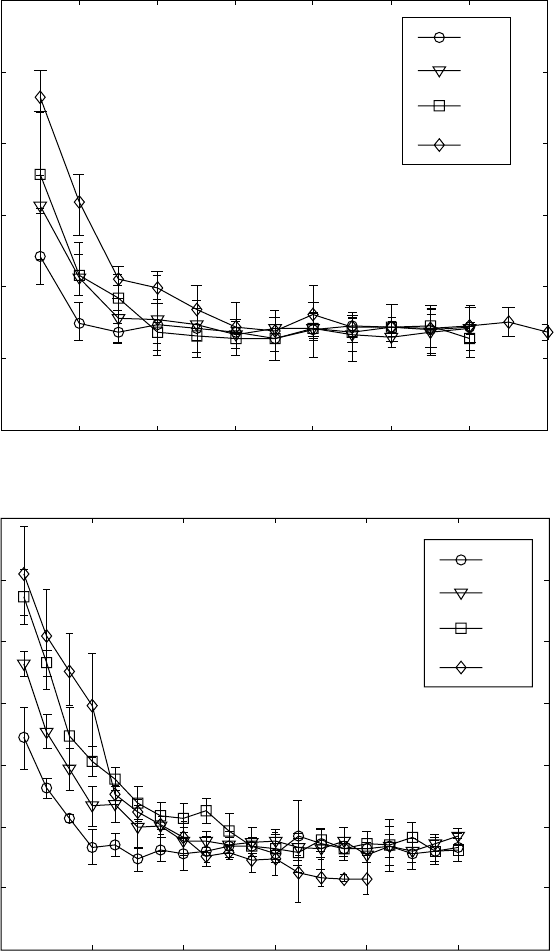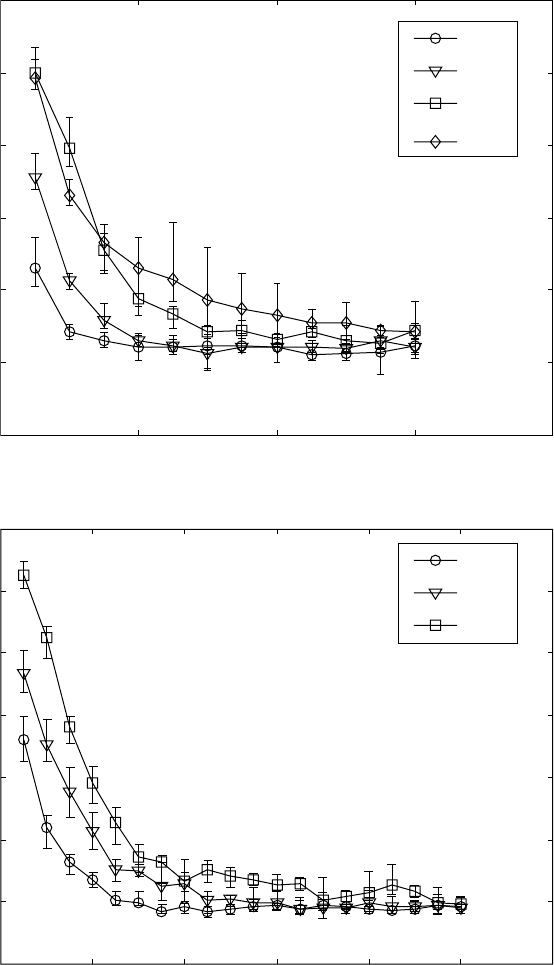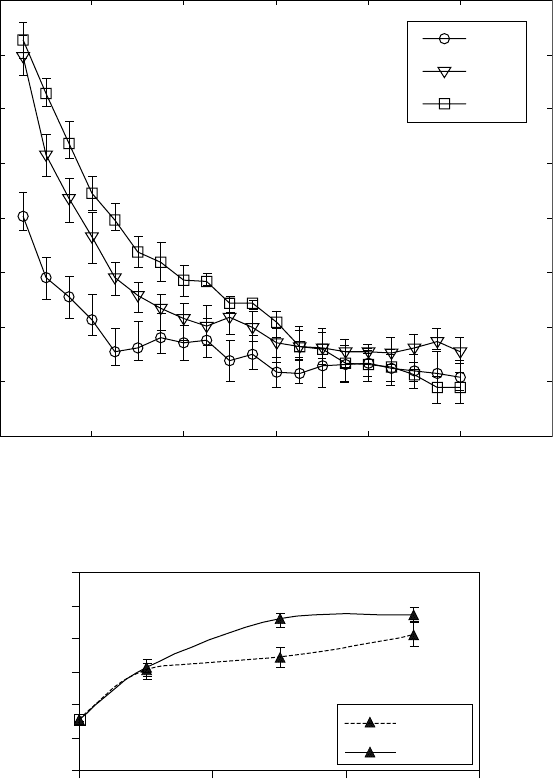Sha W., Malinov S. Titanium Alloys: Modelling of Microstructure, Properties and Applications
Подождите немного. Документ загружается.


Surface gas nitriding: mechanical properties, morphology 453
1 h
3 h
5 h
10 h
0 50 100 150 200 250 300 350
Distance from the surface (µm)
(a)
Hardness (HK0.1)
800
700
600
500
400
300
200
1 h
3 h
5 h
10 h
0 100 200 300 400 500 600
Distance from the surface (µm)
(b)
Hardness (HK0.05)
900
800
700
600
500
400
300
200
17.2
Microhardness profiles of Ti-8Al-1Mo-1V after gas nitriding at (a)
850, (b) 950 and (c) 1050 °C for different periods of time.

Titanium alloys: modelling of microstructure454
1 h
3 h
5 h
0 100 200 300 400 500 600
Distance from the surface (µm)
(c)
Hardness (HK0.05)
900
800
700
600
500
400
300
17.2
Continued
728
530
493
474
470
420
426
418
512
560
100 µm
17.3
Microhardness values (HK0.05) of Ti-8Al-1Mo-1V nitrided at
950 °C for 5 hours showing the decrease of the microhardness
with increasing depth.

Surface gas nitriding: mechanical properties, morphology 455
practical applications because of the high hardness and brittleness of the
surface layer.
17.1.2 Near-α Ti-6Al-2Sn-4Zr-2Mo
The surface hardness increases with the time prolongation, except for at
950 °C from 3 to 5 hours (Fig. 17.5). The hardness decreases with the increase
of the temperature from 950 to 1050 °C after nitriding for 1 and 3 hours. The
higher hardness values at the lower temperature is because the compound
40 µm
435
500
482
17.4
Microhardness values (HV0.1) measured at different
places in Ti-8Al-1Mo-1V nitrided at 1050 °C for 5 hours.

Titanium alloys: modelling of microstructure456
layer was very hard and brittle after nitriding at the higher temperature and
it was destroyed during the hardness measurements.
The microhardness profiles (HK0.05) in the cross-sections are shown in
Fig. 17.6. Maximal values of the microhardness are obtained for this alloy
nitrided at 1050 °C for 5 hours, reaching 1027 HK0.05. The microhardness
increases with time, and with increase of temperature.
From the microhardness profiles, the thickness of the nitrided layer can
be estimated after nitriding at different processing parameters. For Ti-6Al-
2Sn-4Zr-2Mo nitrided at 950 and 1050 °C, the thickness varies between 75
and 200, and 100 and 350 µm, respectively, depending on the length of
nitriding time. The parabolic law of growth may be applied to the variation
of the nitrided layer thickness (Malinova et al., 2001).
17.1.3 α + β Ti-6Al-4V
The surface hardness increases with the time prolongation and increase of
the temperature from 950 to 1050 °C (Fig. 17.7).
For most of the cases, the microhardness increases with the increase of
the time (Fig. 17.8). A maximal value of 770 HK0.05 is recorded for the
alloy nitrided at 1050 °C for 5 hours. The microhardness increases also with
the increase of temperature. Similar results were obtained by Kessler et al.
(2002).
The thickness of the nitrided layer of Ti-6Al-4V increases with the increase
of temperature and time.
17.1.4 Near-β Ti-10V-2Fe-3Al
The surface hardness increases with the time prolongation and with the
increase of the temperature after nitriding for 1 and 3 hours (Fig. 17.9),
0246
Nitriding time (h)
950 °C
1050 °C
Hardness (HV0.5)
1400
1200
1000
800
600
400
200
0
17.5
Surface hardness of Ti-6Al-2Sn-4Zr-2Mo alloy after gas nitriding
at 950 and 1050 °C for 1, 3 and 5 hours.

Surface gas nitriding: mechanical properties, morphology 457
1 h
3 h
5 h
10 h
0 100 200 300 400
Distance from the surface (µm)
(a)
Hardness (HK0.1)
800
700
600
500
400
300
200
1 h
3 h
5 h
0 100 200 300 400 500 600
Distance from the surface (µm)
(b)
Hardness (HK0.05)
1000
900
800
700
600
500
400
300
17.6
Microhardness profiles of Ti-6Al-2Sn-4Zr-2Mo after gas nitriding
at (a) 850, (b) 950 and (c) 1050 °C for different periods of time.

Titanium alloys: modelling of microstructure458
albeit with no significant change of the hardness with the time prolongation
after nitriding at 1050 °C.
As discussed for the previous alloys, the microhardness and the thickness
of the nitrided layer increase with the time prolongation for most of the cases
(Fig. 17.10). They also increase with increase of the nitriding temperature.
The thickness of the nitrided layer for this alloy varies between 25 and 200
µm.
1 h
3 h
5 h
0 100 200 300 400 500 600
Distance from the surface (µm)
(c)
Hardness (HK0.05)
1100
1000
900
800
700
600
500
400
300
17.6
Continued
950 °C
1050 °C
02 4 6
Nitriding time (h)
Hardness (HV0.5)
1200
1000
800
600
400
200
0
17.7
Surface hardness of Ti-6Al-4V after gas nitriding at 950 and
1050 °C for 1, 3 and 5 hours.

Surface gas nitriding: mechanical properties, morphology 459
1 h
3 h
5 h
10 h
0 100 200 300 400 500
Distance from the surface (µm)
(a)
Hardness (HK0.1)
800
700
600
500
400
300
0 100 200 300 400 500 600
Distance from the surface (µm)
(b)
1 h
3 h
5 h
10 h
Hardness (HK0.05)
750
700
650
600
550
500
450
400
350
17.8
Microhardness profiles of Ti-6Al-4V after gas nitriding at (a) 850,
(b) 950 and (c) 1050 °C for different periods of time.

Titanium alloys: modelling of microstructure460
The big variation in the microhardness values for the alloy nitrided at
temperatures higher than the β-transus for Ti-10V-2Fe-3Al is due to the
difference in the irregular microstructure (see Fig. 17.11). That difference
causes the large error bars for Ti-10V-2Fe-3Al nitrided at 850, 950 and 1050
°C (see Fig. 17.10). The values of the microhardness of the white grains are
Hardness (HK0.05)
900
800
700
600
500
400
1 h
3 h
5 h
0 100 200 300 400 500 600
Distance from the surface (µm)
(c)
17.8
Continued
Ti-1023, 950 °C
Ti-1023, 1050 °C
012345 6
Nitriding time (h)
Hardness (HV0.5)
1000
800
600
400
200
0
17.9
Surface hardness of Ti-10V-2Fe-3Al after gas nitriding at 950 and
1050 °C for 1, 3 and 5 hours.

Surface gas nitriding: mechanical properties, morphology 461
1 h
3 h
5 h
10 h
0 100 200 300 400
Distance from the surface (µm)
(a)
1 h
3 h
5 h
0 100 200 300 400 500
Distance from the surface (µm)
(b)
Hardness (HK0.1)
600
550
500
450
400
350
300
250
Hardness (HK0.1)
700
600
500
400
300
200
17.10
Microhardness profiles of Ti-10V-2Fe-3Al after gas nitriding at
(a) 750, (b) 850, (c) 950 and (d) 1050 °C for different periods of time.

Titanium alloys: modelling of microstructure462
1 h
3 h
5 h
0 100 200 300 400 500 600
Distance from the surface (µm)
(c)
1 h
3 h
5 h
0 100 200 300 400 500 600
Distance from the surface (µm)
(d)
Hardness (HK0.05)
900
800
700
600
500
400
Hardness (HK0.05)
1100
1000
900
800
700
600
500
400
17.10
Continued
